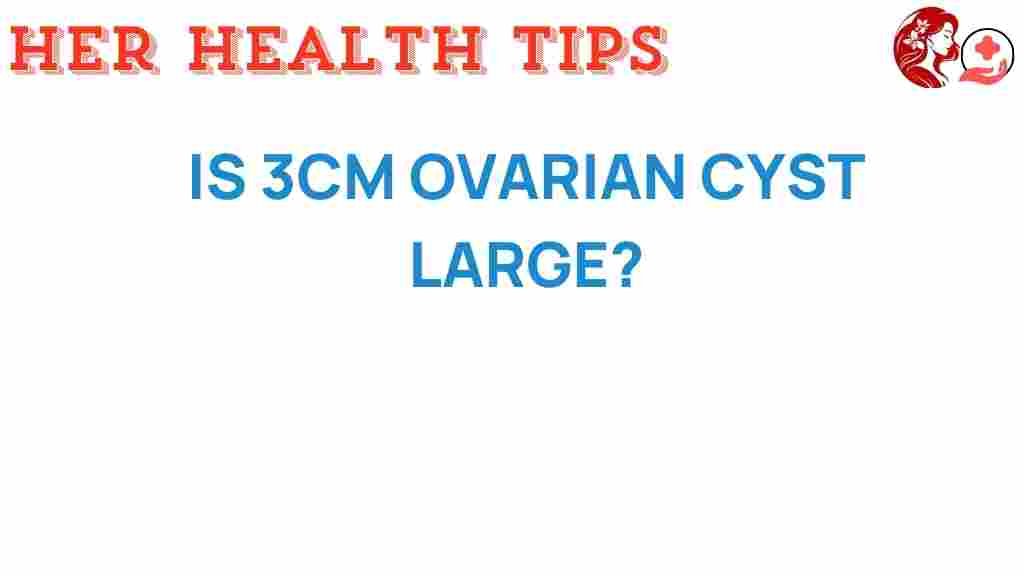Is a 3cm Ovarian Cyst Considered Large? What You Need to Know
Ovarian cysts are fluid-filled sacs that can develop on the ovaries, and they are a common occurrence in women of all ages. While many ovarian cysts are harmless and resolve on their own, questions often arise regarding their size and potential impact on health. One common concern is whether a 3cm ovarian cyst is considered large. In this article, we will explore the implications of cyst size, symptoms, diagnosis, treatment options, and the importance of seeking medical advice for women’s health.
Understanding Ovarian Cysts
Ovarian cysts are categorized into different types, with the most common being functional cysts, which form during the menstrual cycle. Here are some key points to understand:
- Follicular Cysts: These develop when the follicle does not release an egg, and they typically range from 2 to 5 cm.
- Corpus Luteum Cysts: These form after the follicle releases the egg and can grow up to 4 cm.
- Dermoid Cysts: These are less common and can contain various tissue types, such as hair and skin.
- Endometriomas: These are associated with endometriosis and can be larger, often exceeding 5 cm.
Size Matters: Is 3cm Considered Large?
When evaluating ovarian cysts, size can influence the approach to treatment and the urgency of medical intervention. A 3cm ovarian cyst is generally considered to be moderate in size:
- Cysts smaller than 3cm are typically classified as small.
- Cysts between 3cm and 5cm are considered moderate.
- Cysts larger than 5cm are classified as large and may warrant further evaluation.
It’s important to note that the size of the cyst alone does not determine whether it is harmful. Symptoms, type, and other factors also play a crucial role in the assessment of ovarian cysts.
Symptoms of Ovarian Cysts
Many women with ovarian cysts may experience no symptoms at all, especially if the cysts are small. However, when symptoms do occur, they may include:
- Pelvic Pain: This can range from a dull ache to sharp discomfort, particularly during menstruation.
- Bloating: A feeling of fullness or pressure in the abdomen.
- Irregular Menstrual Cycles: Changes in the timing or duration of periods.
- Urinary Symptoms: Increased need to urinate or difficulty emptying the bladder.
- Sexual Discomfort: Pain during intercourse.
If you experience severe pain, fever, or signs of shock, it is essential to seek immediate medical attention, as these may indicate complications such as cyst rupture or torsion.
Diagnosis of Ovarian Cysts
Diagnosing an ovarian cyst typically involves a combination of medical history, physical examination, and imaging tests. Here’s a step-by-step overview of the diagnostic process:
- Medical History: Your healthcare provider will ask about your symptoms, menstrual cycle, and any other relevant health issues.
- Pelvic Exam: A physical examination helps detect any abnormalities in the pelvic area.
- Imaging Tests: Ultrasound is the most common imaging method used. Depending on the ultrasound findings, further imaging (like CT or MRI) may be necessary.
- Blood Tests: These may be performed to rule out pregnancy or check hormone levels.
Understanding the type and size of the cyst is crucial for determining the appropriate course of action.
Treatment Options for Ovarian Cysts
Treatment for ovarian cysts depends on various factors, including the size of the cyst, symptoms, and whether it is benign or potentially harmful. Here are common treatment options:
- Watchful Waiting: If the cyst is small (less than 5cm) and asymptomatic, doctors may recommend monitoring it over time.
- Medication: Hormonal contraceptives may help regulate menstrual cycles and prevent the formation of new cysts.
- Surgery: If a cyst is large, persistent, or causing severe symptoms, surgical options such as laparoscopic surgery may be considered to remove the cyst.
Always consult with a healthcare professional to determine the best treatment plan tailored to your individual health needs.
Risk Factors for Developing Ovarian Cysts
Several factors may increase the likelihood of developing ovarian cysts:
- Age: Women in their reproductive years are at a higher risk.
- Hormonal Imbalances: Conditions that affect hormonal levels, such as polycystic ovary syndrome (PCOS), can lead to cyst formation.
- Previous Ovarian Cysts: A history of cysts increases the chances of future development.
- Pregnancy: Hormonal changes during pregnancy can influence cyst growth.
Understanding these risk factors can help in proactive management of women’s health.
When to Seek Medical Advice
It is critical to seek medical advice if you experience:
- Severe or persistent pelvic pain
- Changes in menstruation
- Unexplained weight gain or loss
- Difficulty urinating or emptying the bladder
Your healthcare provider can offer guidance on whether further evaluation or treatment is necessary based on your symptoms and medical history.
Conclusion
In conclusion, a 3cm ovarian cyst is generally considered moderate in size and often does not pose significant health risks. However, the implications of cyst size, type, and associated symptoms are critical factors in assessing women’s health. Regular check-ups and open communication with healthcare providers are essential for monitoring ovarian health and addressing any concerns.
For more information on ovarian cysts and women’s health, consider visiting reputable sources such as the American College of Obstetricians and Gynecologists for the latest medical guidelines and advice.
If you have further questions or concerns about ovarian cysts, please consult with your healthcare provider for personalized medical advice.
This article is in the category Reproductive and created by HerHealthTips Team
